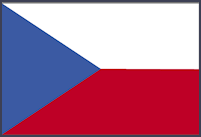The First Czechoslovak Republic
 On November 14, 1918, the interim Parliament declared that the new Czechoslovak state would be a republic, and named Tomas Garrigue Masaryk as the first President. The Czechoslovak Republic (CSR) was composed of the historical Czech lands of Bohemia, Moravia and Silesia as well as Slovakia and Ruthenia (Sub-Carpathian Russia).
On November 14, 1918, the interim Parliament declared that the new Czechoslovak state would be a republic, and named Tomas Garrigue Masaryk as the first President. The Czechoslovak Republic (CSR) was composed of the historical Czech lands of Bohemia, Moravia and Silesia as well as Slovakia and Ruthenia (Sub-Carpathian Russia).
Czecho-Slovakia, a reincarnation of the ancient kingdom of Bohemia, was composed of three former Austrian provinces - Bohemia, Moravia, a part of Silesia - and two former Hungarian provinces - Slovakia, and SubCarpathian Ruthenia. Its peculiarly elongated shape, which the inhabitants proudly compare to that of Britain, lies east and west, across the middle of Europe, for a matter of some five hundred and fifty miles, though its average width, from north to south, is only a hundred and fifty miles. Its western extremity is thrust like a wedge into the southeastern flank of Germany; its eastern extremity touches the northern border of Roumania. Bohemia, the westernmost province, known once as "the pearl of Austria," is-not only the widest and most densely populated; it is the seat of the capital, Prague, and the country's most vital part.
Bohemia, with the adjoining provinces of Moravia and Silesia, forms geographical unity. They are inhabited by Czechs and Germans, with a high standard both of education and of efficiency. But east of Moravia begins the Carpathian mountain range. Slovakia and Sub-Carpathian Ruthenia, the one inhabited by Slovaks, a race close akin to the Czechs, and the other by Ruthenians, both poor and of a low standard of culture, lie side by side on the south slope of this great range, looking not westward toward Moravia and Bohemia, but south, into the plains of Hungary. It is important to remember this geographical anomaly, for upon it depend some of Czecho-Slovakia's most urgent problems.
Within these frontiers dwell five different peoples. The total population was something over thirteen millions, divided, according to Czech statistics, roughly as follows: Czechs, 8,000,000; Slovaks, 2,500,000; Germans, 2,700,000; Magyars, 200,000; Ruthenians, 400,000. The Czechs and Slovaks, who, for most purposes, may be lumped together, form the dominant group; but the Germans and Magyars, who may also be considered together, are an exceedingly active minority, powerful in quality even more than in quantity. As for the Ruthenian mountaineers who inhabit the easternmost Carpathians, their province was given autonomy under a governor, and they played little part in either the political or the economic life of the country.
The constitution of 1920 approved the provisional constitution in its basic features. The Czechoslovak state was conceived as a parliamentary democracy, guided primarily by the National Assembly, consisting of the senate and the Chamber of Deputies, whose members were to be elected on the basis of universal suffrage. The National Assembly was responsible for legislative initiative and was given supervisory control over the executive and judiciary as well. Every seven years it elected the president and confirmed the cabinet appointed by him. Executive power was to be shared by the president and the cabinet; the latter, responsible to the National Assembly, was to prevail. The reality differed somewhat from this ideal, however, during the strong presidencies of Masaryk and his successor, Benes.
To a large extent, Czechoslovak democracy was held together by the country's first president, Masaryk. As the principal founding father of the republic, Masaryk was regarded similar to the way George Washington is regarded in the United States. Such universal respect enabled Masaryk to overcome seemingly irresolvable political problems. Even to this day, Masaryk is regarded as the symbol of Czechoslovak democracy.
The constitution of 1920 provided for the central government to have a high degree of control over local government. Czechoslovakia was divided into zeme (lands), such as Czechia, Moravia, and Ruthenia. Although in 1927 assemblies were provided for Czechia, Slovakia, and Ruthenia, their jurisdiction was limited to adjusting laws and regulations of the central government to local needs. The central government appointed onethird of the members of these assemblies. Centralization prevailed on the next two levels (zupa and okres). Only on the lowest levels, in local communities (mesto and obec) was government completely in the hands of and elected by the local population.
The constitution identified the "Czechoslovak nation" as the creator and principal constituent of the Czechoslovak state and established Czech and Slovak as official languages. National minorities, however, were assured special protection; in districts where they constituted 20 percent of the population, members of minority groups were granted full freedom to use their language in everyday life, in schools, and in dealings with authorities.
Subsequently, interwar Czechoslovakia has been idealized by its proponents as the only bastion of democracy surrounded by authoritarian and fascist regimes. It has also been condemned by its detractors as an artificial and unworkable creation of intellectuals supported by the great powers. Both views have some validity. Interwar Czechoslovakia was comprised of lands and peoples that were far from being integrated into a modern nation-state. Moreover, the dominant Czechs, who had suffered political discrimination under the Hapsburgs, were not able to cope with the demands of other nationalities. In fairness to the Czechs, it should be acknowledged that some of the minority demands served as mere pretexts to justify intervention by Nazi Germany. That Czechoslovakia was able under such circumstances to maintain a viable economy and a democratic political system was indeed a remarkable achievement of the interwar period.
|
NEWSLETTER
|
| Join the GlobalSecurity.org mailing list |
|
|
|

